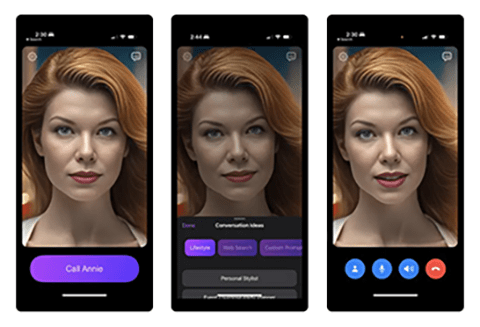
Chat GPT-based avatar Call Annie. Source: Animato Inc. (2023), Call Annie, V. 1.0.1, App Store. bit.ly/3ATU181
EuroCALL Spring Festival
UK/online via Zoom
29 April, 2023
On Saturday 29th April I had the pleasure of taking part in the EuroCALL Spring Festival, both as a presenter and an audience member, as we focused on the ever greater role of technology in language education – and in particular, the arrival of generative AI like ChatGPT.
The day was opened by Mike Sharples in his keynote, Introduction to Generative AI for Student Writing, where he described GPT-4 as a highly trained text completer and style copier, which he sees as offering a vast improvement over GPT-3.5 (which underpinned the original version of ChatGPT, and continues to underpin its free version) and as having changed his working practices around writing.
There are a number of issues with ChatGPT, including student plagiarism (AI detection software is essentially an unpredictability matcher, with independent verification needed of its accuracy levels, and with educators needing to decide whether a rate of 2% false positives, as currently claimed by TurnItIn, is acceptable) and inaccuracy, as seen in ChatGPT’s occasional hallucination of incorrect information and non-existent references (as a language generator, not a database, it is of course not designed to look up facts, has no inbuilt model of the world, and is essentially amoral). When it comes to generative AI, educational institutions have four choices: ban, evade, adapt (requiring new methods of assessment, policies and guidelines) or embrace (involving a long process of building trust). Most universities seem to be taking adapt or embrace approaches.
He mentioned some creative approaches to the use of ChatGPT and similar software. It can be a possibility engine (where an educator or student uses AI to generate multiple responses to an open question, and each student then critiques and synthesises the responses to create their own written answer); a Socratic opponent (where students engage with ChatGPT in a Socratic dialogue as a way of developing arguments and thinking skills); a guide on the side (along the lines of its coming incorporation into Microsoft’s productivity software; a student might instruct it to act as an expert tutor in computing and tutor them as an undergraduate in quantum computing, after which ChatGPT could provide a summary of their current state of knowledge of quantum computing to be sent to their professor); and as a language playground (where it can provide a starting point for academic writing, or translate back and forth between languages and compare the documents generated).
He noted that it is essential for educators and students to develop the AI literacy needed for a world where AI is becoming pervasive.
Following Mike’s keynote, I co-presented a 90-minute workshop, entitled From Chat to Fluency: When Humans and AI Collaborate for Language Education, together with Louise Ohashi and Antonie Alm, with our team presenting from three different locations in Australia, Japan and New Zealand. Our central theme was that to move from simply chatting with AI to using AI with digital fluency, we must develop our understandings and literacies, as well as developing our practices and techniques to allow successful collaboration between humans and AI.
I began with a theoretical introduction which located ChatGPT in the context of recent developments in generative AI, introducing key terminology and outlining benefits and challenges (including highlighting the importance of prompt literacy). Louise and Antonie then demonstrated a range of language learning and language teaching uses of ChatGPT, before examining in more detail how to design appropriate prompts to get the best results from ChatGPT. Participants were invited to log in and try activities in parallel with the demonstrations. We finished with a demonstration of a ChatGPT-based digital assistant, Call Annie (see image above right), released less than a week earlier. This gives us some idea of likely near future developments in this space.
Given the time zone differences, I wasn’t able to stay for any more of the programme. This was not the first time I’ve attended or presented sessions on generative AI this year, and it certainly won’t be the last. Ongoing rapid developments, both technologically and educationally, mean this will be a key topic of our discussions over coming months.